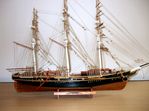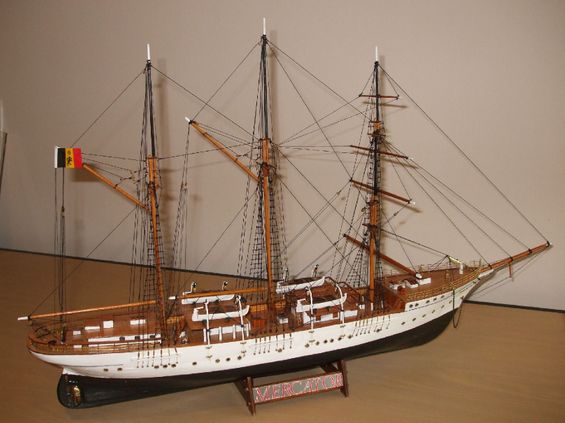Classic Ship Models 16
"Mercator" in Oostende as a floating museum
A PROFILE
"Mercator" 1932
Belgian Merchant Navy Training Vessel
The Barquentine "Mercator" was named after Gerardus Mercator (1512-1594) the famous Flemish cartographer. She was designed by the Antarctic explorer Adriende Gerlache (1866-1934) as a training ship for the Belgian Merchant Navy. She was built in Leith, Scotland and launched in 1932.
Besides being a training ship, she was also used - mainly before the 2nd World War - for scientific observations or as an ambassador for Belgium on world fairs and in sailing events. She participated in several races, winning the 1960 Oslo - Oostende tall ships race. She brought back two Moai (giant statues) from Easter Island and in 1936 brought home from Molokai, Hawaii, the remains of Father Damien. During WW II she was commissioned into the Royal Navy as HMS Mercator and, when based in Freetown, Sierra Leone, she was the support ship for submarine forces in the area.
Her last trip was to Lisbon for the commemoration of the quincentenary of the death of infante Henry the Navigator. In 1961, she became a floating museum firstly in Antwerp and finally at the marina in Oostende, just in front of the city hall. During all this time, she has become the best known ship of Belgium.
Built by Ramage and Ferguson Ltd of Leith, Scotland and launched in 1932 her statistics are:-
Length: 78.5 metres overall 69 metres of hull length
Beam: 10.6 metres Draft 5.1 metres
Mast heights : Foremast 39 metres, Mainmast 41 metres, Mizzenmast 40 metres
Sail plan: 3 masted barquentine, 15 sails, 4 jibs, 4 squaresails, 3 staysails, 2 spankers and 2 gaff sails
Speed 13 knots with a crew of 150 sailors.
THE MODEL
THE MODEL
"Mercator"
Belgian Merchant Navy Training Vessel of 1932
The kit for this model of the "Mercator" is supplied by Mantua Sergal of Italy. and is on a scale of 1:120 creating a relatively small reproduction. It is 650 mms in length, 80 mms width and is 402 mms from keel to topmast.
Being such a limited size, details on deck are fairly basic but do require a lot of care and precision in constructing. Similarly the masts, yards and booms are of small dimensions as are the blocks and associated rigging. Hence the time required to complete
the model was longer than expected.
The double planked hull is made from balsa for the inner and walnut for the outer. The balsa was not supplied with the kit but had been with the model of the "Amerigo Vespucci", but not used. It worked well for the "Mercator" and provide a firm base for the outer planking. Not supplied but optional were 58 portholes. Obtaining these from a local supplier gave the model a more realistic and improved appearance.
The fitting of the deck handrails in fine brass threaded through holed minute brass staunchions again proved a real challenge and was very time consuming. Modellers would find it exasperating to perfect the lines around the bow and the stern. Attaching the timber handrail in the stern to the top of the brass staunchions also requires extreme patience! Instead of following the instructions about the lifeboat covers, it was decided to leave them uncovered, rigging the boats more conventionally and displaying the internals.
Again with this model, it was preferable not to fit the optional sails (not supplied) leaving the vessel in the condition she now appears in Oostende Harbour to this day. It took approximately 5 months to complete at an average of about 5 hours per week. She remains one of my very favourite models on display, with her fine lines, colourful appearance and general neatness.


